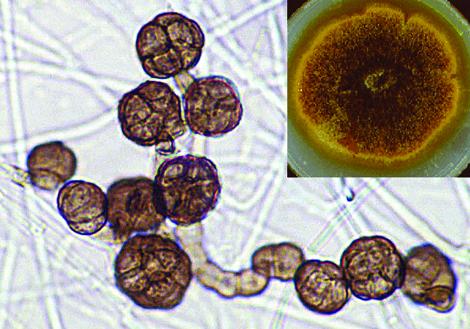Epicoccum nigrum
Synonym:
Epicoccum purpurascens
Epicoccum nigrum is a cosmopolitan saprophyte of worldwide distribution which is occasionally isolated as a contaminant from clinical specimens like skin.
RG-1 organism.

Culture and conidia of Epicoccum nigrum.
Morphological description:
Colonies are fast growing, suede-like to downy, with a strong yellow to orange-brown diffusible pigment. When sporulating, numerous black sporodochia (aggregates of conidiophores) are visible. Conidia are formed singly on densely compacted, non-specialised, determinant, slightly pigmented conidiophores. Conidia are globose to pyriform, mostly 15-25 µm diameter with a funnel-shaped base and broad attachment scar, often seceding with a protuberant basal cell; i.e. aleuric or rhexolytic dehiscence of conidia. Conidia become multicellular (dictyoconidia), darkly pigmented and have a verrucose external surface.
Key features:
Dematiaceous hyphomycete producing darkly pigmented, large globose to pyriform, verrucose dictyoconidia on a sporodochium.
References:
Ellis (1971), Domsch et al. (1980), McGinnis (1980), Samson et al. (1995).
